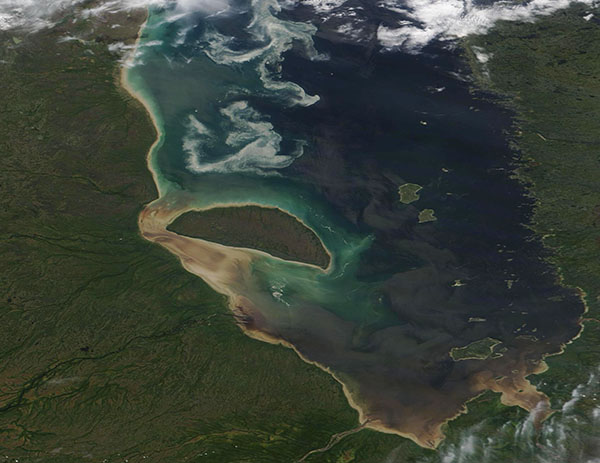Images
June 25, 2024 - Early Summer Color in Hudson Bay
Tweet
As spring gave way to early summer in late June 2024, the waters of southern Hudson Bay resembled an artist’s palette—awash with sepia, sienna, turquoise, and jade shades and topped by splashes of titanium white. The Moderate Resolution Imaging Spectroradiometer (MODIS) on NASA’s Terra satellite acquired a true-color image of the multihued scene on June 23.
The conglomeration of colors is a result of natural events surrounding spring thaw. Each winter, Hudson Bay and all rivers flowing into it freeze over. Snow lays heavily over the surrounding landscape of northeastern Canada. As temperatures warm and sunlight lengthens in late spring, snow and ice begin to melt. Meltwater carries sediment from the land into rivers as well as the Bay. In turn, the rivers dump their sediment load into Hudson Bay as well as creating currents that can stir sediment up from the Bay’s bottom. Sediment appears muddy brown when near the surface but takes on green and blue tones as it sinks below the surface.
In this image, sediment is clearly apparent on the western shore, around Akimiski Island, and in the southern tip of the Bay. Along the shoreline, a mud-colored halo strongly suggests that the primary source of this sediment is likely run-off from the land. The very dark color in the south most likely predominantly comes from the sediment spilled by several large rivers. This color swirls northward towards the center of the Bay, following currents. Patches of bright white in the north are patches of remnants of winter’s sea ice.
Hudson Bay’s freeze-thaw cycle has remained fairly constant over recent decades, with sea ice typically melting between June and August and freeze-up beginning again in late October or November. More recently, the tendency has been for melting to begin early and freeze-up to begin later, extending ice-free days. This is bad news for polar bears, which depend on plentiful ice to successfully hunt for ringed seals and other prey. When ice melts, the bears retreat to shore where food is scarce. They must fast or feed on whatever meager food can be found until ice returns. Since bears burn about 1 kilogram (2 pounds) per day while on land, too much time on shore can lead to stress and starvation.
Image Facts
Satellite:
Terra
Date Acquired: 6/23/2024
Resolutions:
1km (74.1 KB), 500m (193.7 KB), 250m (412.7 KB)
Bands Used: 1,4,3
Image Credit:
MODIS Land Rapid Response Team, NASA GSFC
Tweet
As spring gave way to early summer in late June 2024, the waters of southern Hudson Bay resembled an artist’s palette—awash with sepia, sienna, turquoise, and jade shades and topped by splashes of titanium white. The Moderate Resolution Imaging Spectroradiometer (MODIS) on NASA’s Terra satellite acquired a true-color image of the multihued scene on June 23.
The conglomeration of colors is a result of natural events surrounding spring thaw. Each winter, Hudson Bay and all rivers flowing into it freeze over. Snow lays heavily over the surrounding landscape of northeastern Canada. As temperatures warm and sunlight lengthens in late spring, snow and ice begin to melt. Meltwater carries sediment from the land into rivers as well as the Bay. In turn, the rivers dump their sediment load into Hudson Bay as well as creating currents that can stir sediment up from the Bay’s bottom. Sediment appears muddy brown when near the surface but takes on green and blue tones as it sinks below the surface.
In this image, sediment is clearly apparent on the western shore, around Akimiski Island, and in the southern tip of the Bay. Along the shoreline, a mud-colored halo strongly suggests that the primary source of this sediment is likely run-off from the land. The very dark color in the south most likely predominantly comes from the sediment spilled by several large rivers. This color swirls northward towards the center of the Bay, following currents. Patches of bright white in the north are patches of remnants of winter’s sea ice.
Hudson Bay’s freeze-thaw cycle has remained fairly constant over recent decades, with sea ice typically melting between June and August and freeze-up beginning again in late October or November. More recently, the tendency has been for melting to begin early and freeze-up to begin later, extending ice-free days. This is bad news for polar bears, which depend on plentiful ice to successfully hunt for ringed seals and other prey. When ice melts, the bears retreat to shore where food is scarce. They must fast or feed on whatever meager food can be found until ice returns. Since bears burn about 1 kilogram (2 pounds) per day while on land, too much time on shore can lead to stress and starvation.
Image Facts
Satellite:
Terra
Date Acquired: 6/23/2024
Resolutions:
1km (74.1 KB), 500m (193.7 KB), 250m (412.7 KB)
Bands Used: 1,4,3
Image Credit:
MODIS Land Rapid Response Team, NASA GSFC




